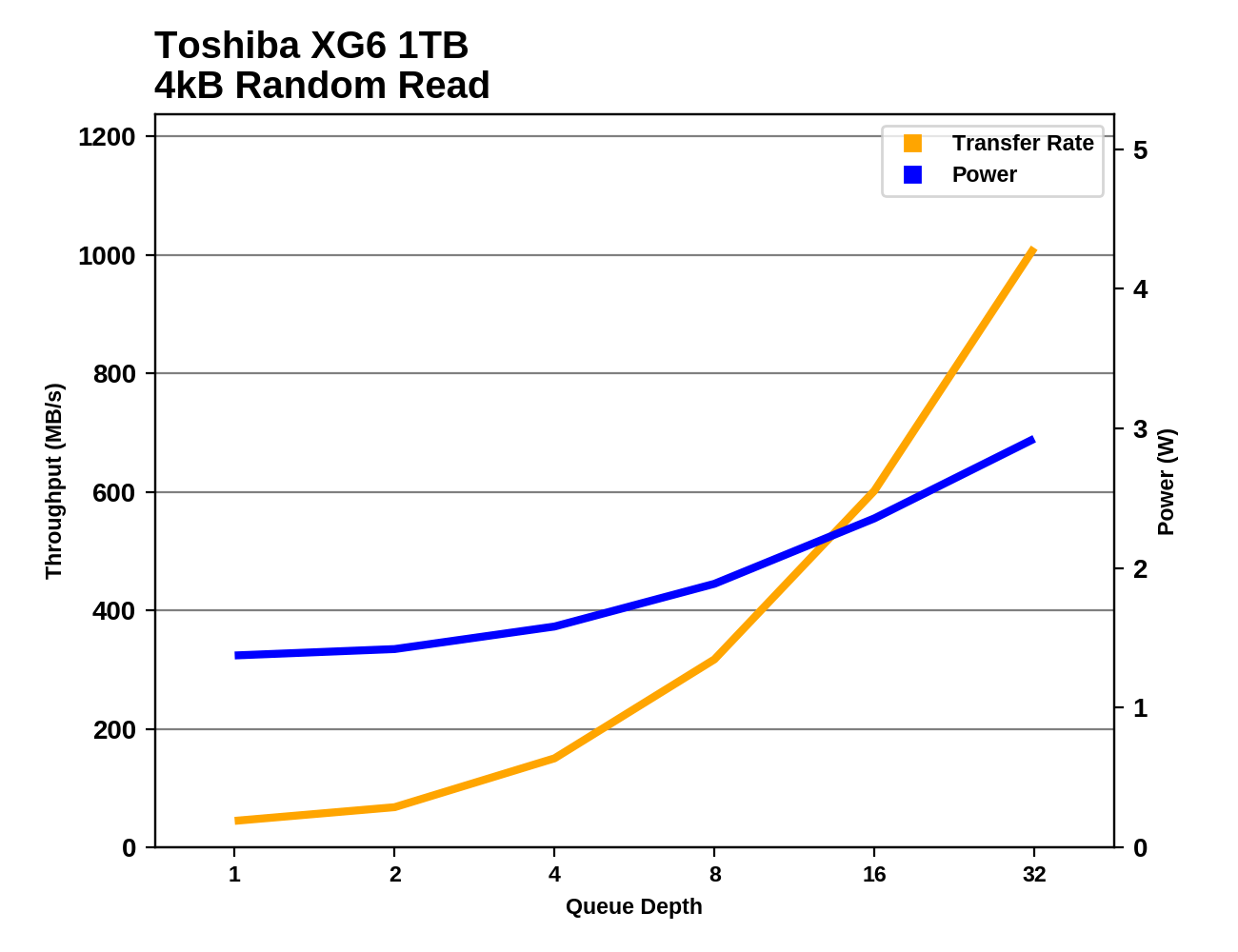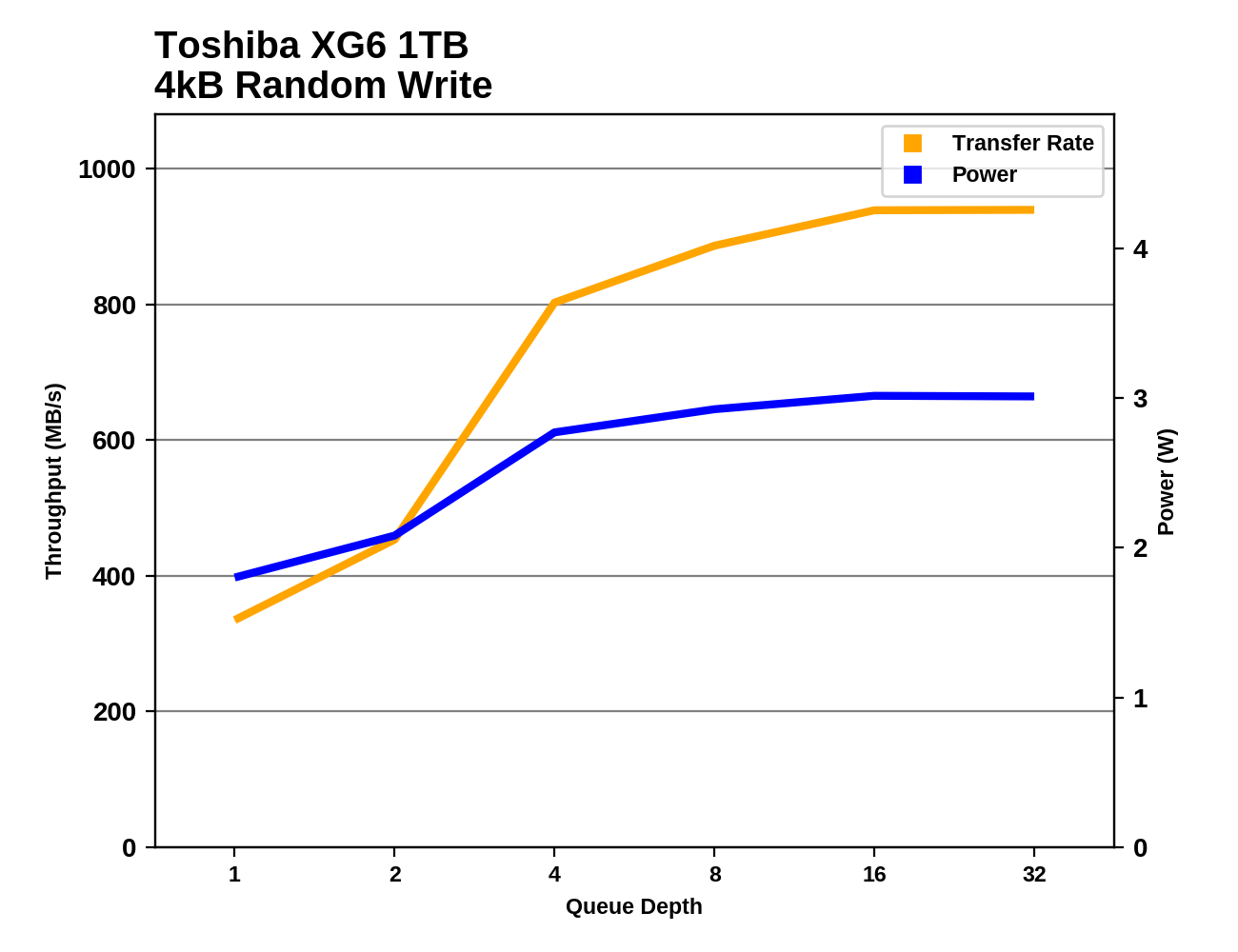The Toshiba XG6 1TB SSD Review: Our First 96-Layer 3D NAND SSD
by Billy Tallis on September 6, 2018 8:15 AM ESTRandom Read Performance
Our first test of random read performance uses very short bursts of operations issued one at a time with no queuing. The drives are given enough idle time between bursts to yield an overall duty cycle of 20%, so thermal throttling is impossible. Each burst consists of a total of 32MB of 4kB random reads, from a 16GB span of the disk. The total data read is 1GB.

The burst random read performance of the Toshiba XG5 was rather slow and the XG6 improves on it but not enough to bring it up to par. Intel/Micron 3D TLC seems to offer substantially lower read latency, though some other drives have managed to get better random read performance out of BiCS TLC than Toshiba's XG series.
Our sustained random read performance is similar to the random read test from our 2015 test suite: queue depths from 1 to 32 are tested, and the average performance and power efficiency across QD1, QD2 and QD4 are reported as the primary scores. Each queue depth is tested for one minute or 32GB of data transferred, whichever is shorter. After each queue depth is tested, the drive is given up to one minute to cool off so that the higher queue depths are unlikely to be affected by accumulated heat build-up. The individual read operations are again 4kB, and cover a 64GB span of the drive.

The rankings for sustained random read performance are largely similar to the burst random read test. The XG6 is improved over the XG5 but there's still quite a bit of room for improvement.
 |
|||||||||
| Power Efficiency in MB/s/W | Average Power in W | ||||||||
The XG6 puts Toshiba back into a tie for the best power efficiency from a TLC drive performing random reads, because the middle of the road performance doesn't require all that much power—just over half the power required by the SM2262EN's class-leading performance.
 |
|||||||||
While the low queue depth random read performance from the Toshiba XG6 is nothing special, it does scale up quite well and by QD32 it has caught up with the SM2262EN and pulled ahead of all other TLC drives.
Random Write Performance
Our test of random write burst performance is structured similarly to the random read burst test, but each burst is only 4MB and the total test length is 128MB. The 4kB random write operations are distributed over a 16GB span of the drive, and the operations are issued one at a time with no queuing.

The burst random write performance of the Toshiba XG6 is about 12% faster than the XG5—not enough to catch up to the fastest drives, but enough to stay above average even as the standards for high-end performance climb from year to year.
As with the sustained random read test, our sustained 4kB random write test runs for up to one minute or 32GB per queue depth, covering a 64GB span of the drive and giving the drive up to 1 minute of idle time between queue depths to allow for write caches to be flushed and for the drive to cool down.

On the longer random write test, the Toshiba XG6 places at the top of the second tier of drives. It can't match the very fastest competitors, but it beats all the more mid-range NVMe drives.
 |
|||||||||
| Power Efficiency in MB/s/W | Average Power in W | ||||||||
The XG6 has leapfrogged the WD Black to retake the lead in power efficiency during random writes, with about a 7% performance per Watt lead. Even with the improved performance relative to the XG5, the XG6 is is still one of the least power-hungry NVMe drives during this test.
 |
|||||||||
The random write performance of the XG6 scales best from QD2 to QD4 which brings it near saturation. This pattern is similar to the behavior of drives from Samsung, WD and the XG5, while the Phison and Silicon Motion controllers seem to pick up the pace a bit earlier with better QD2 performance.










31 Comments
View All Comments
halcyon - Monday, September 10, 2018 - link
Sorry for the typos, mobile posting on the fly... Wish there was at least a 1min edit/fix window for new posts...